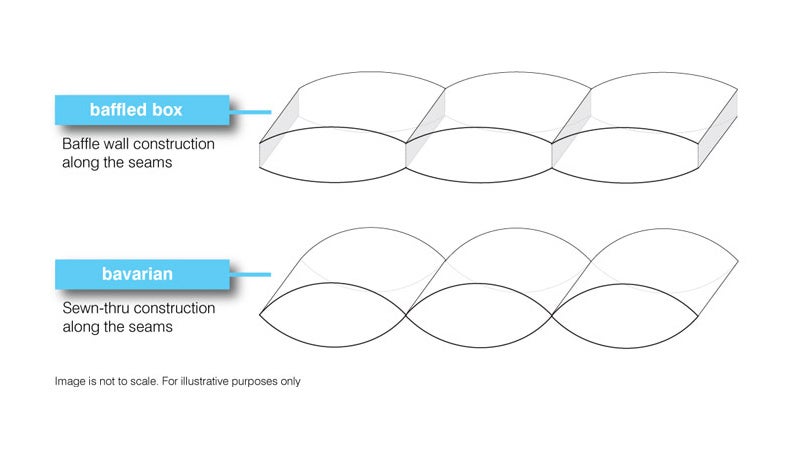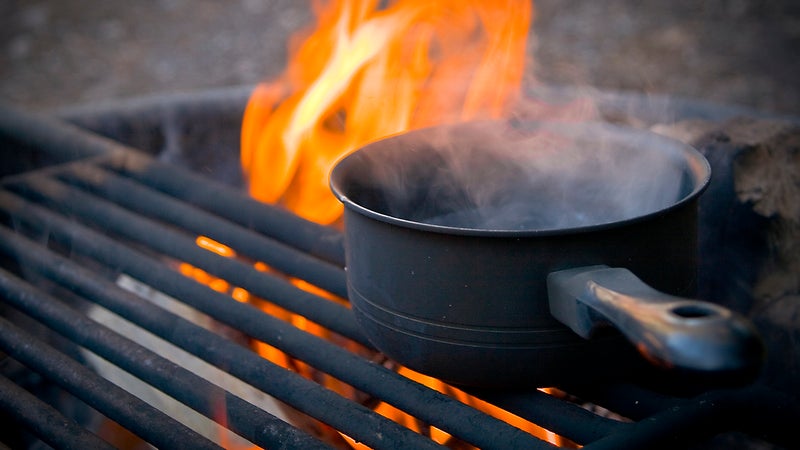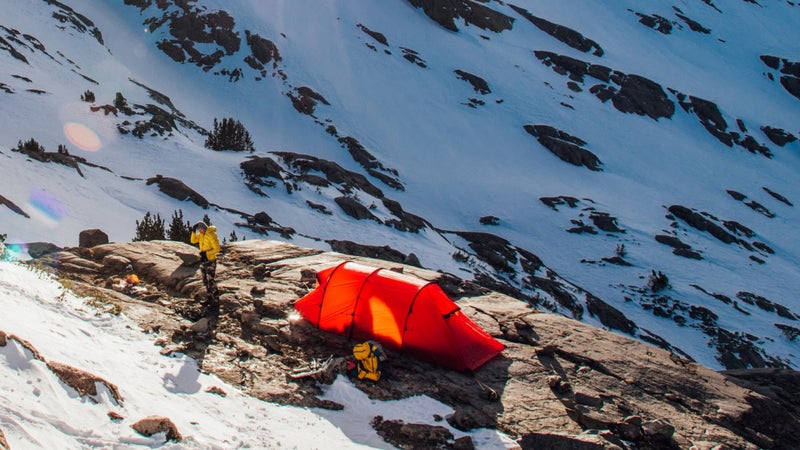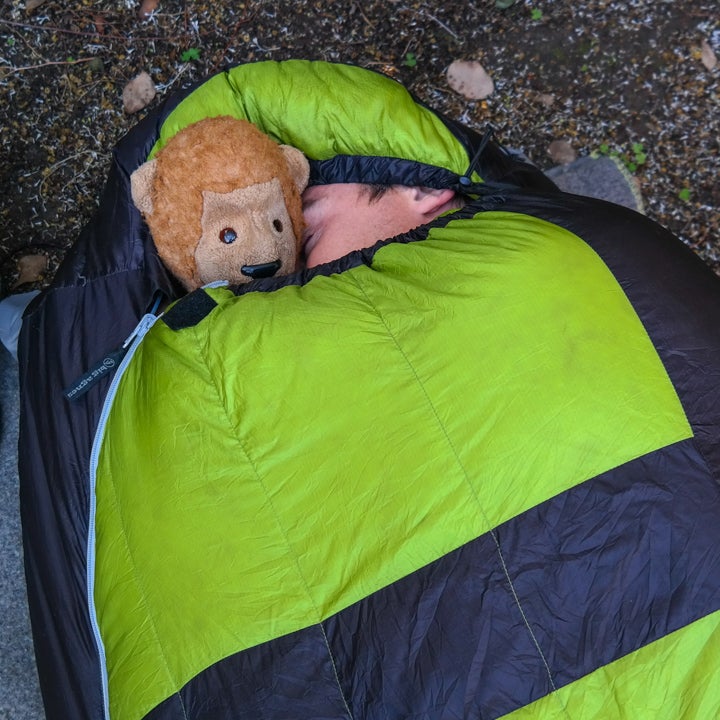It’s camping season. And even in the height of summer, the mountains get cold at night. Here’s a collection of knowledge that you can apply to your next camping trip, to ensure that you and your camping partners have the best time possible.
Know Your Enemy
It can be hard to predict weather conditions in the backcountry. Mountains influence and create their own weather. But there are a few general rules that can help you at night.
First, temperatures drop 3.3 degrees Fahrenheit with every 1,000 feet you gain in elevation. So if you’re heading to a campsite 6,000 feet higher up than the last town you pass through, you can assume nighttime lows will be about 20 degrees colder than what’s forecast below.
You can also use mountain terrain to your advantage. Cold air will flow downhill at night and gather in depressions and valleys. Try not to sleep in those. Often the best campsites will be partway up a slope rather than at its bottom.
You’ll also want to shelter from the wind. While prevailing winds tend to travel from west to east in most of the country, wind in the mountains tends to run downhill and through valleys. Try to find natural barriers that will block those winds that come from above.

Understand Your Insulation
Any sleeping bag sold at REI these days has to be tested to . This defines two temperature ratings: comfort and lower limit. Those are what they sound like. But everyone sleeps differently, brands perform the tests themselves (meaning the numbers are self-reported and may be influenced by marketing or sales needs), and the test employs mannequins equipped with base layers. So you can’t just look at a bag’s name, see a number on it, and assume it will work for you close to or at that temperature.
There are also different types of insulation inside bags. We all know that down can lose its loft, and therefore its ability to insulate, when it gets wet. This is particularly problematic in cold conditions, where you may be dealing with both precipitation outside your tent and condensation inside it. But down tends to have greater warmth-to-weight and warmth-to-packed-size ratios than synthetic alternatives, which retain their ability to insulate when wet.
There are also down treatments (Nikwax and Downtek are the most common), which coat down clusters and give them some ability to retain loft when wet. Which one’s best for you comes down to cost and your unique needs. I use treated down in any sleeping bags I’ll need to carry in a backpack, but I prefer the synthetic alternative for vehicle or boat-based camping.
The quality of a down-filled sleeping bag is determined by its shell material (the lighter the better, if you’re carrying it), its shape (less extra space within a bag will help you sleep warmer but may be less comfortable), and the fill power of the down itself. I see a lot of people mistaking fill power as an indication of warmth. It’s not. Fill power is the number of cubic inches one ounce of the down in question can loft into when uncompressed. A higher number will pack smaller and lighter than a lower number. It’s the volume of that loft that provides the insulation. How efficiently you get there is largely a matter of how much money you want to spend.

What You Sleep on Is as Important as What You Sleep Under
The temperature ratings for most sleeping bags are only valid when the bag is paired with an R-value sleeping pad of 4.0 or greater. That’s because cold ground will literally suck the heat out of your body through conduction cooling without a decent pad below you. That process begins at temperatures as warm as 68 degrees and obviously gets worse as temperatures drop.
R-value is a measure of how well a sleeping pad resists the flow of heat and therefore how much insulation it provides. The higher the number, the warmer the pad, but high R-value pads tend to be heavier and more expensive, too.
Beginning next year, brands selling pads through REI will be required to standardize their R-value testing procedures and report them to consumers. But as it stands now, we have no unified R-value methodology being used industry wide. There’s no way to know how a brand has arrived at the R-value it reports, if it even reports one in the first place. Many brands simply offer a suggested temperature range.
Unless you know your pad’s R-value, and trust it, then there’s no way to guartnee that you’re getting the best performance out of your total sleep system. If you are sleeping cold in temperatures within your sleeping bag’s performance range, your pad is likely the culprit.

Stay Dry
We all know that getting wet makes you colder. But moisture remains a common culprit for nighttime chills outdoors.
One way moisture may enter your sleep system is through your socks, base layers, or hat. If you’ve been wearing those during the day, through periods of exertion, then they may retain sweat even if they feel dry to the touch. I always carry a dedicated pair of nighttime socks as a result. You may want to do the same with base layers and a hat if you have room to carry them.
It’s also a tent’s job to keep you dry, not just by keeping rain off but by venting the moisture you release from your body and breath as you sleep. Tents capable of blocking wind while still ventilating all that moisture are key to comfort in cold conditions. Over single-wall mountaineering designs, I prefer to use a tent with a mesh body and to-the-ground rain fly in cold conditions for that reason. Look for vent ports in the rain fly, which you can open to facilitate the escape of all that moisture. If you wake up in the morning with a veritable terrarium of water droplets inside, then that tent does not vent as well as you need it to. Tents are also designed to be oriented to the wind in a certain direction in order to facilitate maximum ventilation and stability. Consult the manufacturer for those instructions.

Start Warm
Beginning your night with adequate warmth will help your sleep system continue to perform at its best as both the ambient temperature and your body temperature drop.
First, make sure you have unpacked your sleeping bag and thoroughly shaken it out as much in advance of bedtime as possible. This will allow its insulation to decompress and reach its maximum loft before you require it to provide insulation. You also need to make sure that the insulation distributes throughout the bag as it decompresses, hence the vigorous shaking.
Next, take adequate warmth into the sleeping bag. To do this, you need a good source of heat, which can either be a hot-water bottle or your body. I like to boil water, put it in a strong heat-appropriate container (such as a stainless-steel water bottle), and throw that into my sleeping bag (about halfway down, where your crotch will end up) 30 minutes or so before I turn in. Make sure you use a leakproof, uninsulated bottle for this purpose. Alternately, you can perform some sort of low-exertion exercise to increase your body temperature before bedtime—jumping jacks work great. Just make sure you stop before you start sweating; you don’t want to bring that moisture to bed with you.
It’s also important to eat high-calorie, slow-burn food before you go to bed. Fats like nuts, chocolate, or olive oil work best. If your meal doesn’t have enough of those in it, you can add them. Butter and olive oil aren’t just great ways to make camping meals taste better, they also set you up for a warmer night.

Practice Makes Perfect
So how do you know if your new sleep system is going to work as you expect it to? Before relying on it across a challenging, multi-night trip, take it out somewhere local, with low risk, and see how it performs. Evaluate its comfort as you use it, in some place where getting a bad night’s sleep is of low consequence. Then ask yourself both if it’s adequate (if not, return it) and what you can do to get more performance from it.
The two-person sleep system I use while car camping with my fiancée, for example, allows a draft to enter between our heads when either of us shifts around. Based on using it outside the family cabin a couple weeks ago in mild temperatures, I plan to add some Velcro or snaps between the hood and body, to help it lock in warmth, before we take it on more challenging trips. Similarly, my ultralight backpacking quilt works best if paired with a light fleece midlayer jacket in addition to my base layers. I know through experience that I need to make sure I have that piece in my setup and that I’ve selected one free of bulky zippers and extra fabric that sleeps the most comfortably. I also know that that I’ve owned for probably 15 years (and is blackened from innumerable wood fires) works best as a hot-water bottle. It has a simple screw-on lid with no spout, which means it has never once leaked, so I know I can rely on it not only to add appreciable warmth but that it won’t soak my sleep system and ruin my night.
You should seek to gain knowledge and make iterative improvements like these every time you camp, too. If you are uncomfortable while camping, you are doing it wrong.


